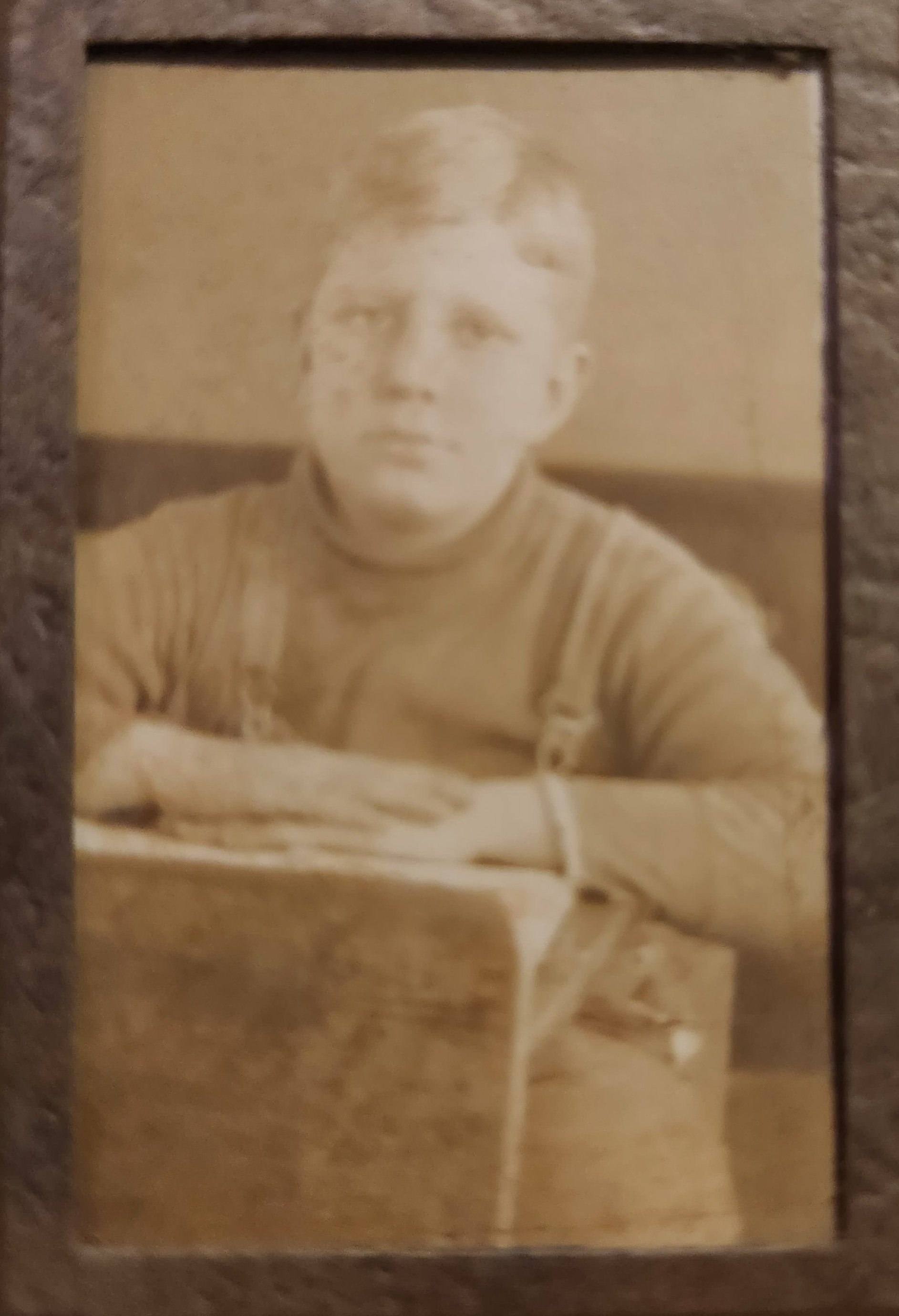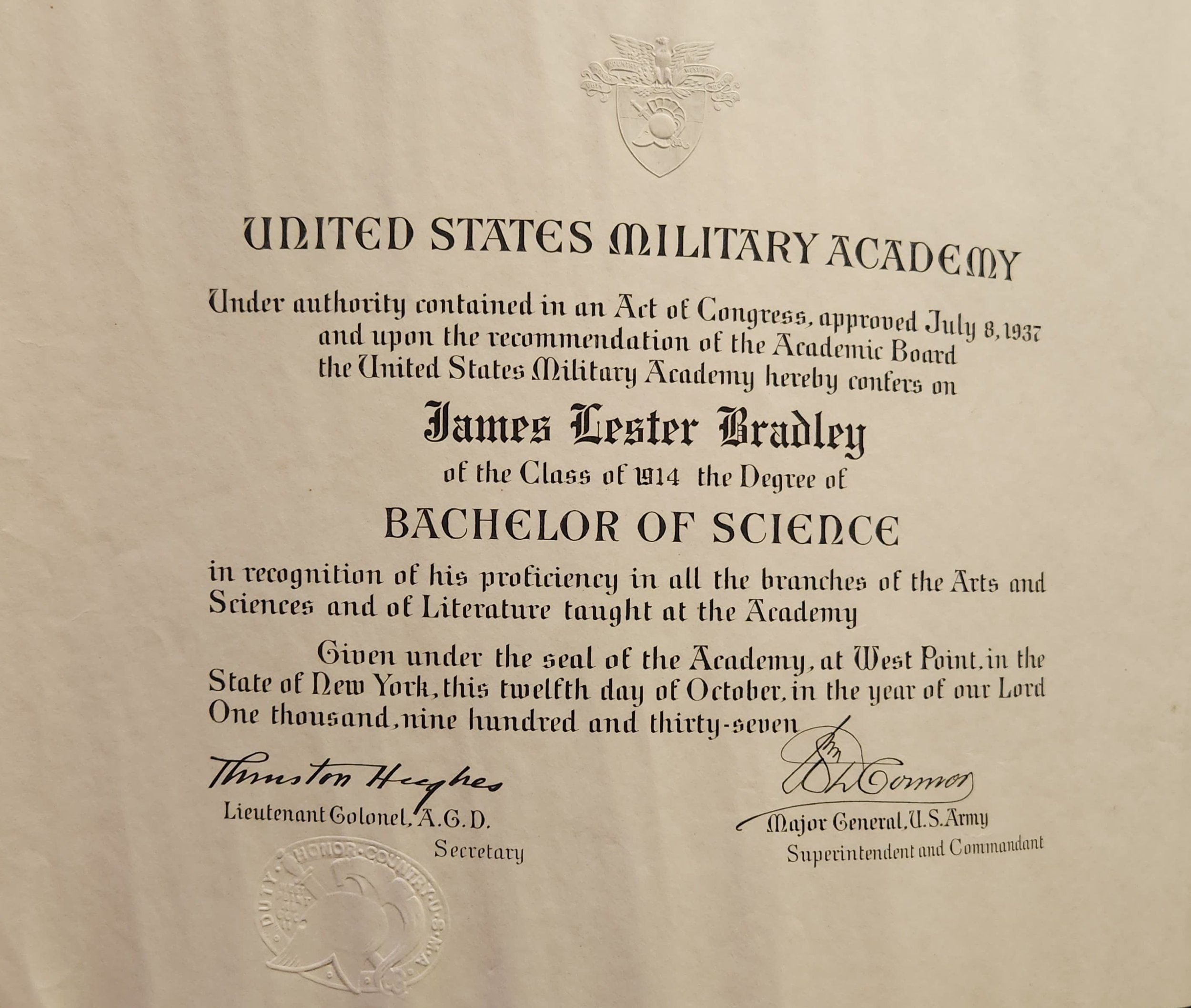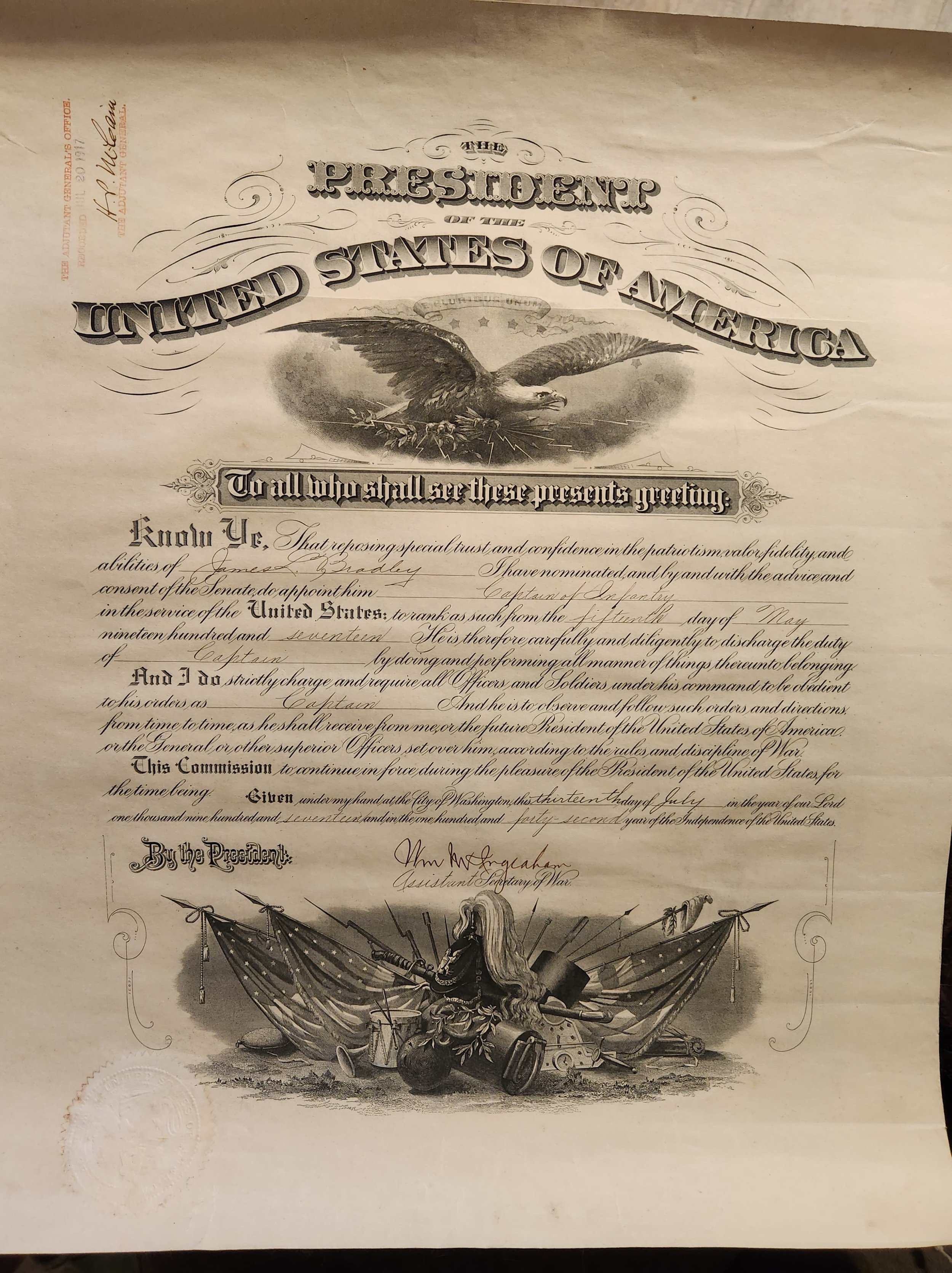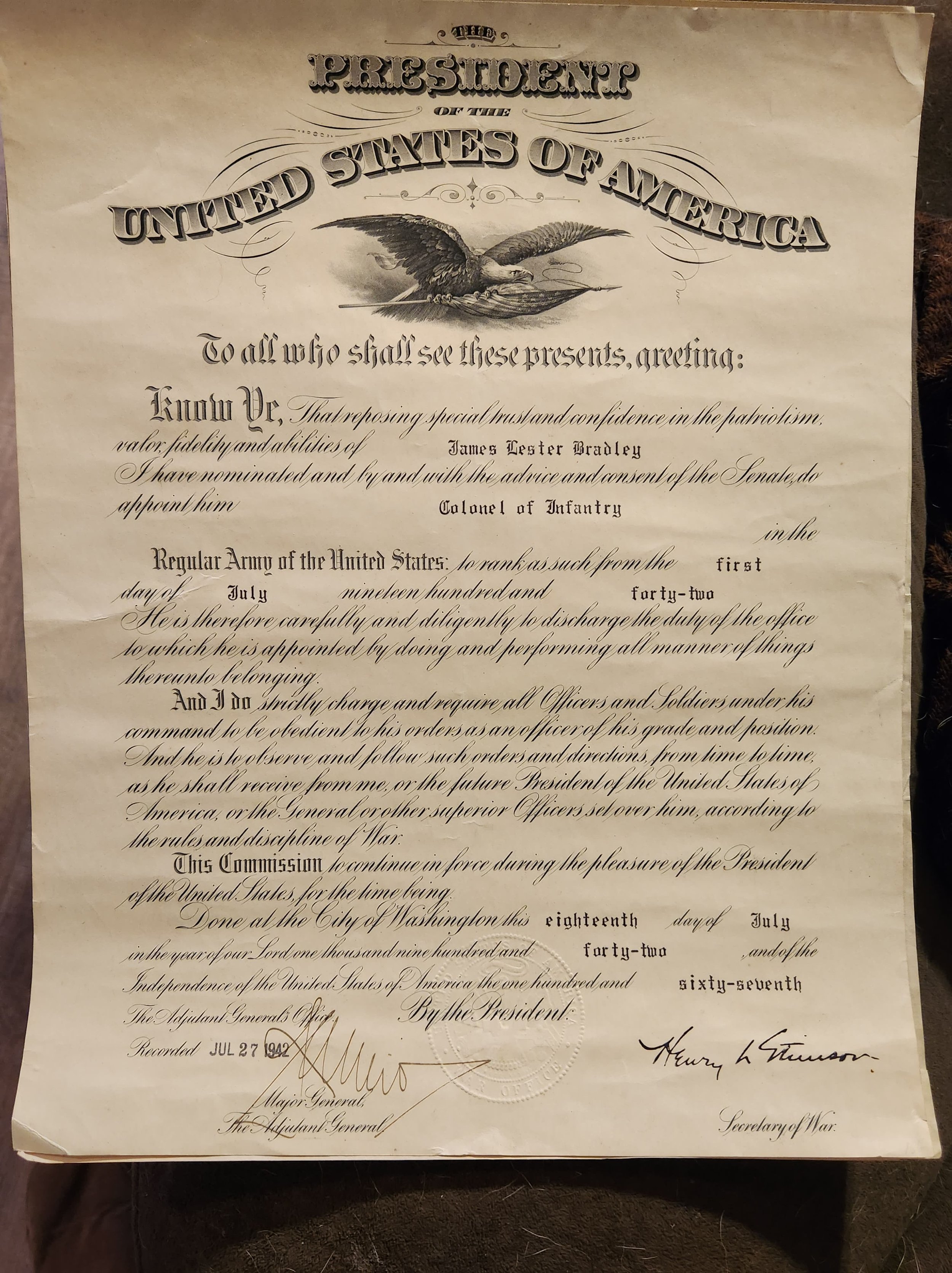GENERAL JAMES BRADLEY
James Lester Bradley was born on 18 May 1891 in Doniphan, MO, to Spencer Price and Mary Watts Bradley.
James was a Cadet at the U.S. Military Academy from 1 March 1910 to 12 June 1914, when he graduated and was commissioned a Second Lieutenant in the U.S. Army Infantry and assigned to the 19th Infantry Regiment. During his time at West Point, he became friends with a Cadet in the Class of 1915, named Dwight David Eisenhower.
Bradley served at:
Vera Cruz, Mexico, 18 September- 25 November 1914;
Galveston, TX, to 3 December 1914;
Naco and Douglas, AZ, with 22nd Infantry, to 3 February 1915;
Galveston, TX, with regiment, to 18 September 1915;
Del Rio, TX, Camp and District Adjutant, to 4 June 1916;
Fort Sam Houston, TX, Acting and Battalion Adjutant, to 1 June 1917, when he was transferred to 57th Infantry;
Camp Travis, TX, to 10 July 1917;
Camp Stanley, TX, to 7 October 1917;
McAllen, TX, Commanding Post to 24 October 1917;
Fort Sill, OK, Student Officer at Infantry School of Arms to 25 November 1917, when he graduated;
Brownsville, TX, 27-30 November 1917;
Fort Sill, OK, Instructor at Infantry School of Arms to 5 October 1918;
Camp Benning, GA, Secretary of Infantry School of Arms,17 Oct to - .
During this period, Bradley received promotions to:
First Lieutenant, 19th Infantry, 1 July 1916;
Captain, 19th Infantry, 15 May 1917;
Major of Infantry, National Army, 17 June 1918.
Bradley's other assignments included: Command and General Staff School in 1925; Army War College in 1930; and Instructor, Command and General Staff School in 1932.
He was promoted to Colonel in 1940 and served first as Assistant Chief of Staff, 4th Army, then as Chief of Staff, 4th Army.
Bradley was promoted to Brigadier General in September 1941 and to Major General in June 1942. He became Commanding General of the 96th Infantry Division when it was activated on 15 August 1942, and commanded the Division through its entire existence in World War II; it was deactivated on 3 February 1946. Under his command, Bradley led the previously untested 96th Infantry Division into two major battles in the South Pacific: Leyte and Okinawa.
The Battle of Leyte in the Pacific campaign of World War II was the invasion and conquest of Leyte in the Philippines by American and Filipino guerrilla forces under the command of General Douglas MacArthur, who fought against the Imperial Japanese Army in the Philippines led by General Tomoyuki Yamashita from 17 October to 31 December 1944. The battle launched the Philippines campaign of 1944-45 for the recapture and liberation of the entire Philippine Archipelago and to end almost three years of Japanese occupation.
The Battle of Okinawa, codenamed Operation Iceberg, was fought on the Ryukyu Islands of Okinawa and was the largest amphibious assault in the Pacific War. The 82-day battle lasted from early April until mid-June, 1945.
The battle has been referred to as the "Typhoon of Steel" in English, and tetsu no ame ("rain of steel") or tetsu no bōfū ("violent wind of steel") in Japanese. The nicknames refer to the ferocity of the fighting, the intensity of gunfire involved, and to the sheer numbers of Allied ships and armored vehicles that assaulted the island. The battle resulted in one of the highest number of casualties of any World War II engagement. Japan lost over 100,000 troops, and the Allies suffered more than 50,000 casualties. Simultaneously, more than 100,000 civilians (12,000 in action) were killed, wounded, or committed suicide. Approximately one-quarter of the civilian population died due to the invasion.
Five divisions of the U.S. Tenth Army, the 7th, 27th, 77th, 81st, and 96th, and two Marine Divisions, the 1st and 6th, fought on the island while the 2nd Marine Division remained as an amphibious reserve and was never brought ashore. The invasion was supported by naval, amphibious, and tactical air forces.
The main objective of the operation was to seize and secure a large island only 340 miles away from mainland Japan. After a long campaign of island hopping, the Allies were approaching Japan, and planned to use Okinawa as a base for air operations on the planned invasion of Japanese mainland, coded Operation Downfall. The atomic bombings of Hiroshima and Nagasaki and Soviet entry into the war caused Japan to surrender just weeks after the end of the fighting at Okinawa.
The 96th Infantry Division received a Presidential Unit Citation for its heroic actions during the Battle of Okinawa. As a result, the 96th Infantry Division is one of only four entire Army Divisions awarded the Presidential Unit Citation for heroic action during World War II.
Major General Bradley retired from the Army in 1947.
Personal
James L. Bradley married Pauline Clarkson of San Antonio, TX, on 6 December 1916 in Del Rio, TX. James and Pauline had only one daughter, Mildred C. Bradley Walter. Pauline preceded James in death on 28 September 1949, in San Mateo, CA.
Death and Burial
Major General James Lester Bradley died of drowning in a swimming pool at his daughter's home in Lafayette, CA, on 30 July 1957. He had been under treatment for a heart ailment. His daughter, Mildred, found him in the pool and is his only survivor.
He is buried at San Francisco National Cemetery in San Francisco, CA
MG James Lester Bradley
From: https://militaryhallofhonor.com/honoree-record.php?id=3263



















